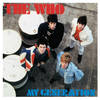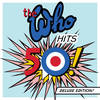On Air Now
X-Posure with John Kennedy 11pm - 2am
26 October 2024, 13:00

The Who’s classic Mod rock opera is now over 50 years old... but what inspired the title?
Quadrophenia - it’s an album and a film. But what does that title mean?
The Who’s classic double LP was released on 26th October 1973 and looked back at the previous decade and the Mod culture that spawned the band in the Shepherd’s Bush area of West London. It follows the tale of the troubled teen Jimmy, whose immersion into the Mod world of late nights, parties, cheap stimulants and tribal violence against their bitter rivals the Rockers quickly leads him into trouble.

The album got to Number 2 in the UK album charts - being kept off the top by David Bowie’s set of cover versions, Pin-Ups - and the story was turned into a film with the same title, which premiered on 16th August 1979.

Quadrophenia Trailer (1979)
Starring a young cast of then-unknowns, Phil Daniels took the role of Jimmy, while Sting (about to become a megastar with The Police) was the “Ace Face” and Leslie Ash (later of Men Behaving Badly fame) played Jimmy’s girlfriend.

Also in the cast was a young Ray Winstone, who played an old school friend of Jimmy’s who - shock! horror! - turns out to be a greasy rocker, with leathers and everything.

The film caused a brief revival of Mod music and styles at the end of the 70s, but one element of the story that’s not so clear to anyone who’s only watched the film is: what does that title mean? The film doesn’t elaborated, but the explanation is buried in the sleevenotes to the original album.

Remember Quadrophonic sound? No? It was an early attempt to create “SurroundSound” using four speakers rather than the usual two for stereo. The equipment was costly and didn’t catch on, but for a time in the early 1970s, it was a luxury item for audiophiles.
Some albums - Floyd’s Dark Side Of The Moon, Kraftwerk’s Autobahn and John Lennon’s Imagine, for example - were mixed and released in quadrophonic editions.

So, in 1973, when Pete Townshend was writing his rock opera about a confused young man coming to terms with his identity, he picked on both the hi-fi lingo and some outdated ideas about mental illness.
Back in the 60s and 70s, schizophrenia was characterised with the cliched “split personality”, rather than as “a mental disorder characterised by abnormal social behaviour and failure to understand reality”.

As the confused, weary and stimulant-driven Jimmy explains in the sleevenotes: “It must be alright to be plain ordinary mad… Schizophrenic? I'm bleeding Quadrophenic.”
"I think that our album clarifies who the real hero is in this thing," said Townshend in 1973. "It's the kid on the front. He's the hero. That's why he's on the front cover. That's why he's sung about. It's his f***ing album."
Quadrophenia was released in the UK on 26th October 1973, but an ongoing dispute over oil prices meant there was a shortage of vinyl, meaning the album wasn't available in all parts of the UK, so the LP only charted a few weeks later - at Number 2, right behind David Bowie's Pin-Ups.



